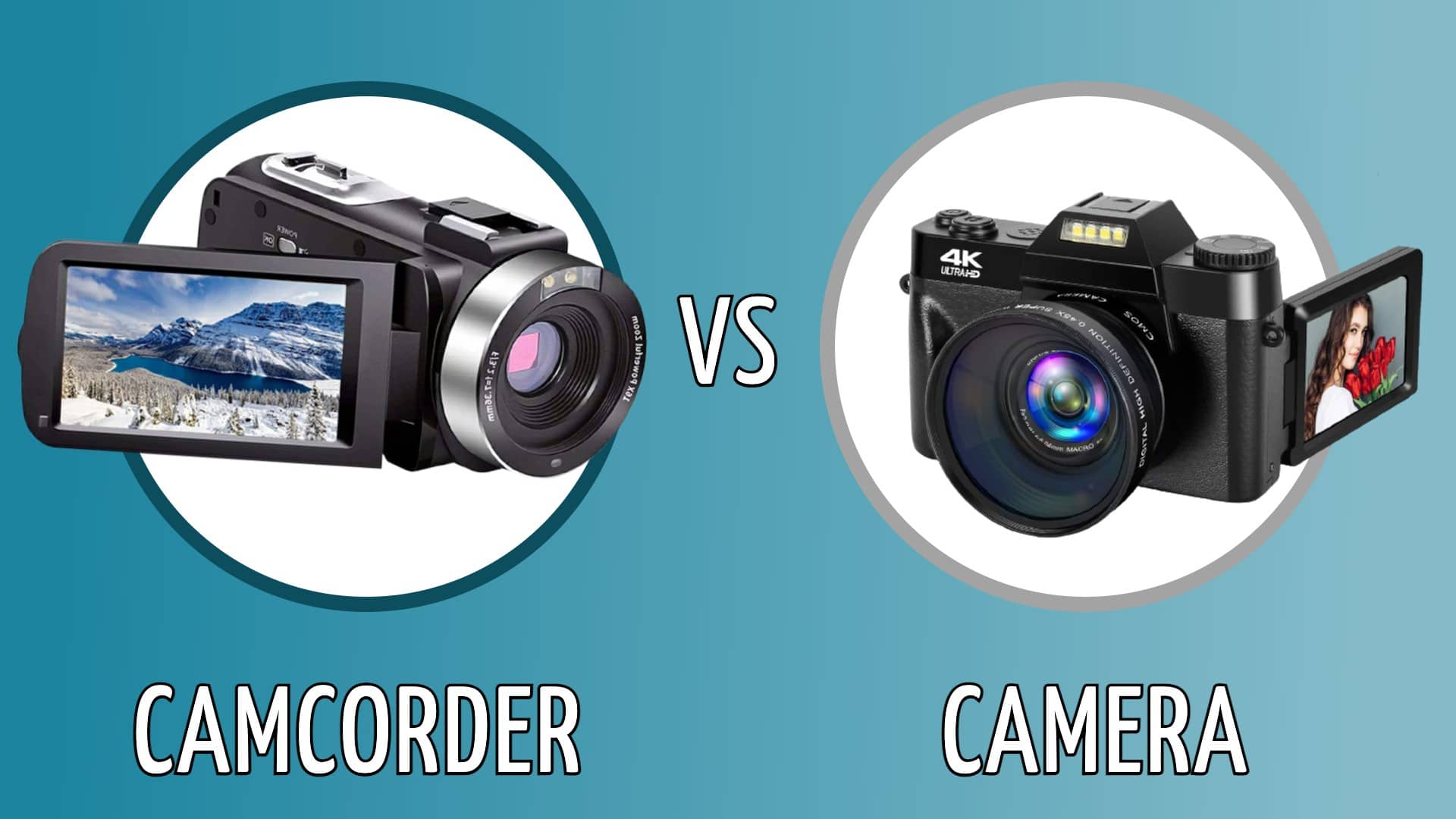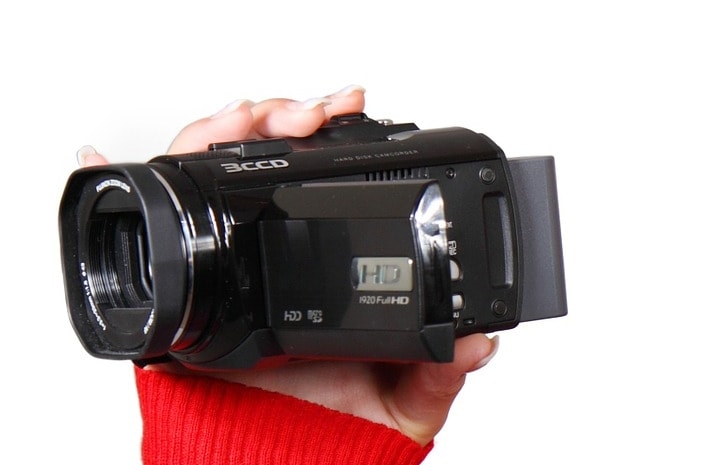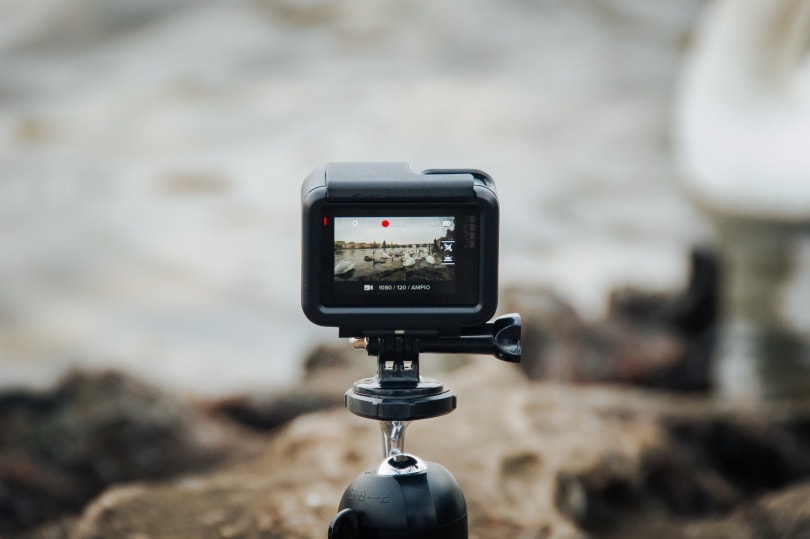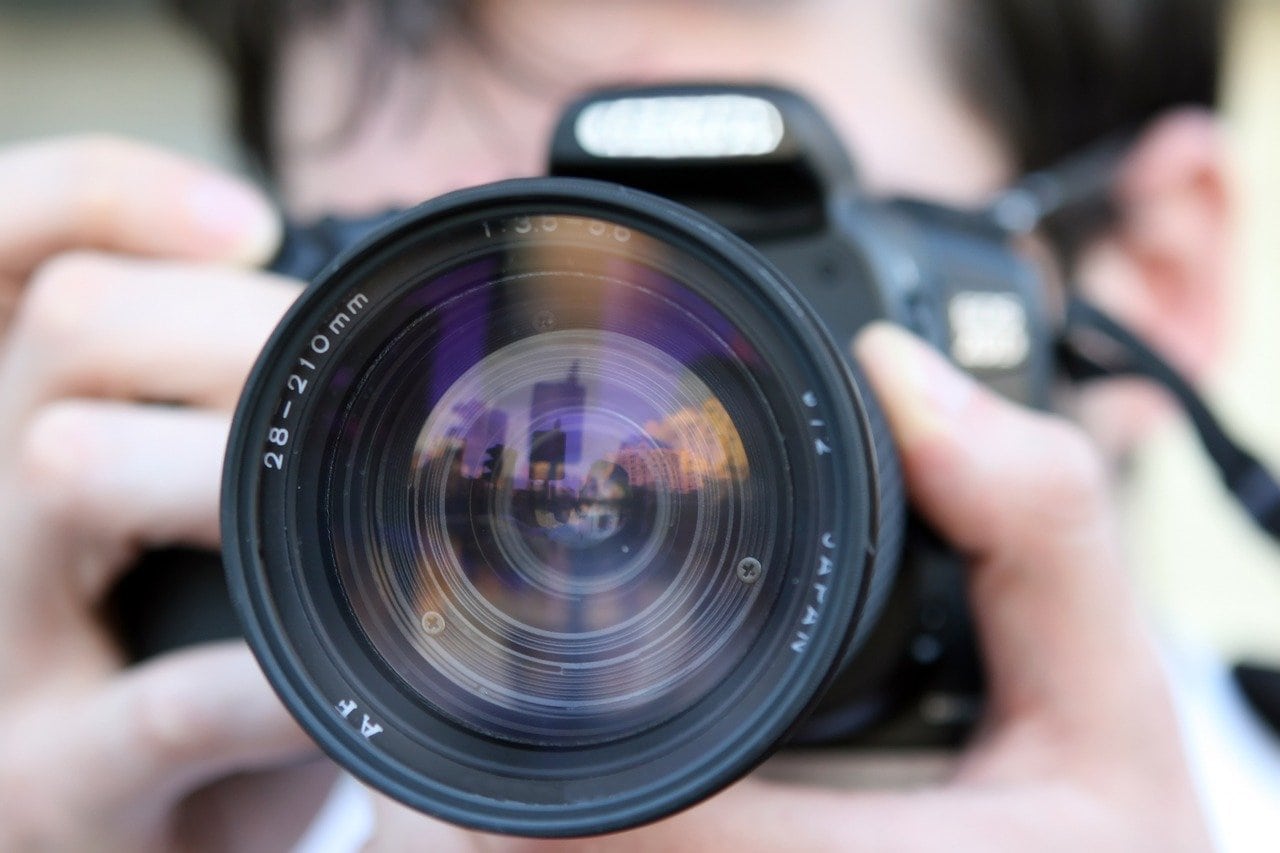Camcorder vs Camera: Which Is Better for Your Needs?
Last Updated on

You know, you should be very grateful these technological advancements have helped the industry improve the quality of pictures and videos taken using camcorders and cameras. Back in the day, it was very difficult to capture a breathtaking video, even if you had a wealth of experience in the field.
Ironically, these advancements also came with new problems. And a good example is the conundrum before us today. Anyway, let’s just stop beating around the bush, and get to it. Or what do you say?

Camcorders: General Overview

Have you ever found yourself in a situation where you wish you had something that could record some audio—or even live-motion video—for later playback, but you didn’t quite know the type of device that was more appropriate for such a task? Yes? Well, at least now you know a camcorder can get the job done.
Inside this electronic device, you’ll find three major components: There’s the recorder that’s responsible for the conversion of electrical signals into digital video, the lens that gathers light, and the imager, which is the place where all that light is being focused.
If you weren’t around in the late 70s or early 80s, and someone tried to convince you that these gadgets are modern tech, you wouldn’t have any reason to doubt them. But the truth is, they’re really old. They’re obviously not obsolete, but old.
During those days, filmmakers used to refer to them as video cameras or simply recorders. And they were mostly useful when producing films for commercial sale.
In What Format Was the Data Recorded?

The first model could only record in one of two formats. We had the Betamax and the VHS analog formats. Betamax, for those who can remember, was a videocassette recording technology that was developed in Japan by Sony. The player could only use a magnetic tape, which was 1.27 centimeters in width.
VHS, as an acronym, stands for Video Home System. In 1976, a Japanese company that goes by the name JVC (Japan Victor Company) introduced us all to this analog format. It also uses a magnetic tape of the same width.
The videotape cassettes were like today’s hard drives. They were used to store all the recordings, which were to be replayed using a VCR (Video Cassette Recorder). But to use the VCR, you had to first hook it up to a TV set, which acted as the monitor at the time.
A lot has changed since then. Great strides have been made in various technological fields, and as a result, we now have more formats—High-Definition Video, MP4, Hi-8, 8mm, and S-VHS. By the way, the difference between these current formats and the ones that we had before can be seen in the number of recording hours, the image clarity, color iterations, and more importantly, storage efficiency.
The data stored can also be edited as per the consumer’s preference, something that could only be dreamt of. All you have to do is connect the device to a PC using a Universal Serial Bus, and you’ll be able to access and edit everything that’s recorded in there.
What if you don’t have a PC? Don’t sweat it. Just look for a camcorder that has been designed with built-in editing software.
Types of Camcorders
When it comes to camcorders, there’s a variety to choose from. And you’ll realize every single one of them has merits and demerits. Whatever works for you will depend on two factors: The recording time, and the price tag.
Not until recently, people only used to invest in Standard Definition camcorders. But now, high-definition is slowly gaining popularity. That being said, if you’ve been thinking about investing in one of these bad boys, think about the future.
1. Mini-DV Camcorders

Documentary filmmakers are very knowledgeable when it comes to this type of camcorder since they’ve served the industry for eons. And to be honest, that’s why we’re sad to hear that they’re being phased out.
You see the thing is, they were designed to only use tapes, but people prefer using hard drives nowadays. Tapes are only capable of giving you 60-90 minutes of recording time, while hard drives offer more. We think the only reason why they’ve been around this long is that tapes are budget-friendly and easy to find.
2. DVD Camcorders

This is not the type of camcorder that we’d typically go for if we’re in the filmmaking business. Its footage is usually highly compressed, thereby compromising the quality standard of the video.
But we’ll admit this; when it comes to convenience, it certainly takes the number one spot. You really don’t have to do much when you’re ready to play your recording. Just pop out the DVD, and insert it into the player.
3. Hard Disk Drive Camcorders (HDD)

This right here is the future of “camcording”. It’s also the place where you’ll have to pay more attention, seeing as things are about to start getting a little bit more scientific.
First off, HD and HDD are two very different things. The former refers to High Definition, while the latter is a Hard Disc Drive. Secondly, not all HDD camcorders are HD. They come in formats. There’s the Standard Definition (SD) and the High Definition (HD). And lastly, the HD will be built into the device, just the same way it is in a computer.
There’s an obstacle that might discourage you from using a camcorder. Once the device is filled up with footage, you’ll have to look for a computer to transfer or download the data. If you cannot find a computer, you’ll have to stop shooting because there won’t be any space left to store additional data.
Also, hard drives are very fragile. Shaking or inadvertently bumping it might damage the whole thing.
4. Flash Memory Camcorder

As the name suggests, they do store footage on flash drives. You could either use an SD card—which is a storage drive that most people prefer using—or a memory stick. Lucky for you, unlike hard drives, they’re not that susceptible to damage. But they do cost a pretty penny and offer less space.
5. Combo Models
Flexibility. That’s what you’re being offered here. If you’ve noticed that the drive is filling up but you left your PC back home, you can simply insert a flash disk and go on with your business like nothing ever happened.

But Why Use A Camcorder Instead of A Camera?

We’re not denying that a modern camera can record a video just as well as a camcorder. All we’re saying is if your job description has the phrase “shooting videos” written in bold, your best bet is working with something that has been specifically designed to shoot or record videos.
The way this tool has been designed, it can sit comfortably in anyone’s hands for hours, without making them feel tired. Or why else do you think they often come with straps? In addition, they traditionally come with some sort of stabilization software. A piece of software that ensures the videos recorded are visible, even if the guy responsible for the shoot didn’t have stable hands.
The tilt and swivel screen is a unique feature that you’ll rarely find in any modern camera. This type of screen gives you more room to work with, making it easier for the user to compose a perfect shot.
We’d have loved to stop here, seeing as those features are a clear indication the handheld ergonomics of this device supersede those of a typical camera, but we still have to talk about the video quality. No modern camera can produce a video in ultra-high-definition quality. And that’s because cameras don’t come with autofocus systems or built-in calibrated zoom lenses.
Quick question; when was the last time you saw a camera with an omnidirectional built-in microphone? Never? You see, that’s simply because they don’t come with such a feature. But camcorders do. This audio input usually helps it record high scores in the sound-check department.
The only time that you’ll regret using a camcorder is when you’re recording a low-light video. They normally have smaller sensors in comparison to their comrades.
- Has a stabilizing software
- Comes with straps
- Omnidirectional built-in microphone
- Produces ultra-high-definition videos
- Built-in calibrated lenses
- Small sensors
- Not ideal for taking photos
- Not great at recording at low light

Cameras: General Overview

First off, let’s get something out of the way. In general, there are two types of cameras. We have the DSLR and the SLR. The SLR, otherwise known as the film camera, is the outdated kind. Well, some people still use it, but it’s outdated nonetheless, thanks to technology.
An SLR camera is the type of camera that we used to see as kids—you know, the kind that only recorded images using films. The DSLR camera, on the other hand, records data using a digital sensor.
The DSLR abbreviation stands for Digital Single-Lens Reflex. We’ve already explained the Digital bit, so there’s no need of going over that a second time. We’ll just move on to the Single-Lens part of that acronym, which is meant to tell you that the device frames, focuses, and takes pictures using one lens. Reflex is a term mostly used to refer to optical systems that have been designed to direct incoming light to the viewfinder. In other words, while using this gizmo, you’ll be able to see the scene’s exact optical view.
Types of Cameras
We decided to first talk about the DSLR and the SLR (film) cameras because they’re considered the OGs in the industry. Well, the SLRs mostly, but you get what we mean. Let’s now look at the other types of cameras, and what they bring to the table.
1. Mirrorless Camera

The primary difference between the mirrorless camera and the DSLR is the optical viewfinder. The DSLR has one while the mirrorless camera doesn’t. That’s the main reason why the mirrorless camera generally feels lighter compared to the DSLR, and is easier to handle. They also have a detachable lens feature, but due to the fact that they’re still new in the industry, finding the right type of lens for the device is a nightmare.
2. Rugged Camera
https://www.instagram.com/p/CCmuAE-sSx3/
Did someone call for a waterproof and shockproof camera? Because we’ve got one here. With a rugged camera, the difference lies in the build quality. Globetrotters or adventurers tend to gravitate towards this type of camera for one reason: they can withstand virtually anything you throw at them. Heat, the cold, fog, water, you name it.
3. GoPro Cameras

They call it GoPro cameras, but we like referring to them as spy cameras. They’ll fit into almost anything, including places that can’t hold normal sized cameras. Ever seen that camera that’s normally mounted on a cyclist’s helmet? Yup, that’s the one.
4. Medium Format Cameras

Here’s a fun fact: Medium Format Cameras are technically SLRs. We say technically because they used to use films, but those films were replaced by digital camera sensors. So in a way, they evolved and never went extinct.
Fashion photographers have, for some reason, fallen deeply in love with this type of device. Might have something to do with the fact that they’re known to produce exceptionally high-quality images, or because they customarily look sophisticated. Who knows!
5. Point and Shoot Cameras

Going on a vacation? This is the camera for you. They’re compact, have a variable focal length, fixed lens, and record images in the JPEG format.
By the way, trying to acquire a telephoto reach using this type of camera is pointless, and that’s why they’re often used for documentation alone.

What Makes Cameras So Different from Camcorders?

We don’t dispute the fact that it’s a cool all-around option. It’s just that… even though it can very much hold its own when shooting videos, it still has nothing on the camcorder. The winds will only shift to its favor when we start talking about photography. We all know cameras, especially DSLR cameras, are designed to take amazing photos.
Does that mean they can’t shoot full HD videos at all? They still can, but the differences will be noticeable. Unless you invest in a mirrorless camera that’s typically designed to offer more than just the typical features. The problem is, to own such a piece of equipment, you’ll probably have to first rob a bank or something.
Professional photographers prefer mirrorless cameras to DSLR because they’re not only lighter, but also compact. And because their sensors are ridiculously larger, they tend to produce better quality videos in low light when compared to camcorders.
The other perk that we’d like to add is the storage capability of a camera. As mentioned earlier on, camcorders conventionally store data in a built-in drive. Cameras, on the other hand, use SD cards. So even if you’re not the sharpest tool in the box you’ll be able to tell the storage space in the camcorder is clearly an issue.
The only bummer is, you’ll have to invest in an external microphone that might make your setup appear bulky.
- Takes amazing photos
- Larger sensors
- Produces quality videos in low light
- Higher storage capacity
- Lightweight
- Compact
- Doesn’t have an external microphone
- Not ideal for recording HD videos

Conclusion
Okay, that brings us to the end of today’s piece. We hope this information was enough to at least give you an inkling of what’s best between a camcorder vs camera and which is best suited for your needs. But the key takeaway is, camcorders are specifically designed for video recording, while cameras mostly deliver when it comes to photography.
- See also: 10 Best Camcorders for Kids
You might also be interested in: 5 Best Cameras for Bird Photography – Reviews & Top Picks
About the Author Robert Sparks
Robert’s obsession with all things optical started early in life, when his optician father would bring home prototypes for Robert to play with. Nowadays, Robert is dedicated to helping others find the right optics for their needs. His hobbies include astronomy, astrophysics, and model building. Originally from Newark, NJ, he resides in Santa Fe, New Mexico, where the nighttime skies are filled with glittering stars.
Related Articles:
How to Clean a Refractor Telescope: Step-by-Step Guide
How to Clean a Telescope Eyepiece: Step-by-Step Guide
How to Clean a Rifle Scope: 8 Expert Tips
Monocular vs Telescope: Differences Explained (With Pictures)
What Is a Monocular Used For? 8 Common Functions
How to Clean a Telescope Mirror: 8 Expert Tips
Brightfield vs Phase Contrast Microscopy: The Differences Explained
SkyCamHD Drone Review: Pros, Cons, FAQ, & Verdict
